
The dragon boat festival is a totem festival. Falling on the 5th of the fifth lunar month, it is close to the summer solstice. Pestilence, as a result of the heat and dampness, is at its worst, threatening lives of human community. Images of legendary animals and totem animals are pasted on the door or carried along for safeguard. Inevitably, the theme of art works for this festival is awareness of life and safety.
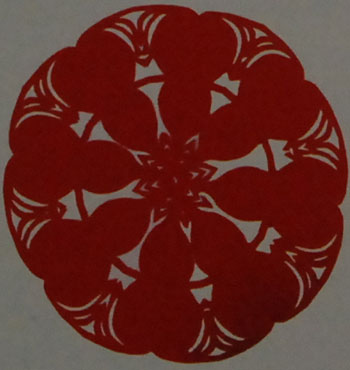
Folk paper-cut the "Eight diagram gourd" to keep evil spirits away on the Dragon Boat Day during the fifth lunar month (Jiaocheng, Shanxi).
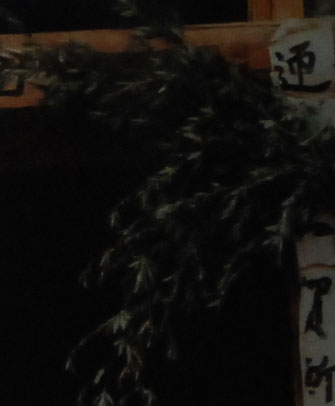
Mugworth hanging on the door of every household on the Dragon Boat Day (Songtao, Guizhou).
Chinese mugwort was considered a magic herbal medicine to cure heat and damp related disease in ancient time. As a result, Mugwort became a legendary panacea to idol. According to the Chinese local chronicles, "Use cattail on the Dragon Boat Day and insert mugwort at the door side prevent bad luck and get rid of illness", and "paste cattail and mugwort paper cow on the door on The Dragon Boat Day keeps sickness away." In the fifth Lunar month, every household started hanging red ornaments, putting out cattail dragon or mugwort tiger, and decorating windows with auspicious red paper toad. Young girls cut out letter "Fu" in layers for good luck; and small kids wore bright red toad made of broomcorn, garlic, and other plants to ease the heat of the summer and keep off disease. These customs are still widely practiced today as folk festivities on the Dragon Boat Day.
The Dragon Boat Festival for the people in northern Guizhou was to make totem dog with mugwort and hang it on lintels. It would be kept their till the following year, and then added more mugwort to it. It grew bigger every year to over 2 meters long. Both Han and Miao nationalities followed the same custom. If a kid got sick, they would take some mugwort from the dog's tail and boiled it in water as medicine, which would rid of pestilence. Shaanxi, a tiger totem area, people hanged mugwort tiger on the lintel. Nowadays, it has changed to using stuffed "mugwort tiger" made in fabric and stuffed with dried mugwort incense. Stuffed tiger is sewed on children's clothes on the Dragon Boat Day for safeguard. Its lovely puffy shape gained the name of "Ai tiger/' some kids wear a stuffed tiger and a rooster on each shoulder as a local saying goes: "The rooster holds you in the mouth, and the cat (tiger) watches over you."
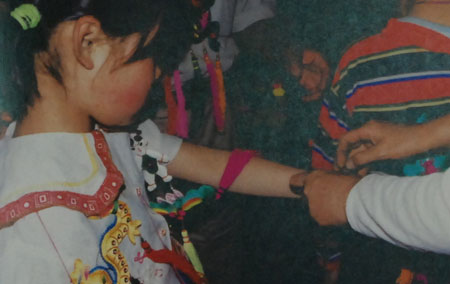
Talisman bags that mothers have kids wear on the Dragon Boat Day (Zhengning, Gansu).
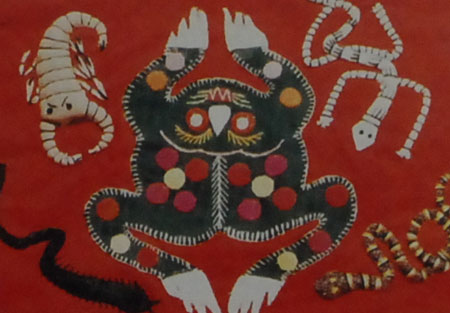
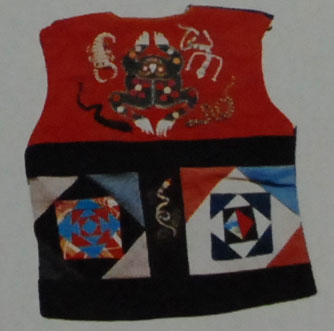
Vest with "Five poisonous" symbols to keep the evil spirits away (Qianyang, Shaanxi).
From eastern Gansu to Central Shaanxi plains, people wear vests with totem frog and tiger symbols as antidotes to the five poisonous (snake, scorpion, lizard, beetle and centipede). Kids carry on their backs stuffed mugwort animals like snake, frog, crab (its eight feet symbolize the sun rays), with "five poisonous" pendants. On the chest are small ornaments of legendary animal figures stuffed with dried mugwort, including the snake, the monkey, the rat, the dragon, the horse, the cow or plant bags of the pumpkin, the garlic, the grape, the peach, and the bean. There are also symbols of perpetual life like the eight diagram lenses, star anise, or broomcorn, pyramid-shaped dumplings, lotus bud fireworks, book casket, fan, etc., a variety collection. Their creative, casual design seemed far better than the embroidery craft works with complicated design and intensive craftsmanship.
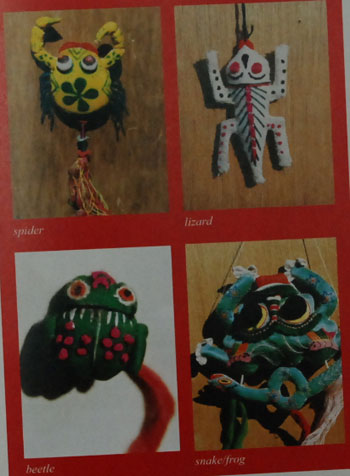
"Five poisonous" ornaments in the shape of spider, lizard, snake/frog and beetle, crab and eight diagram lenses dumpling (Zhengning, Gansu)
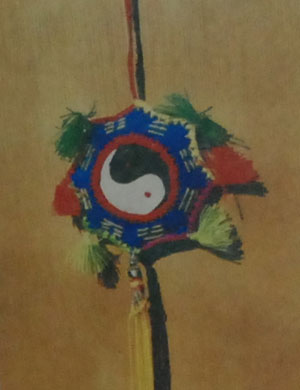
Eight diagram lenses
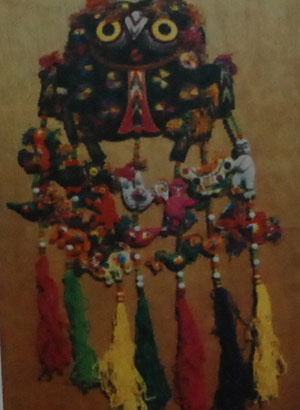
Crab
In northern Shanxi, the symbol of perpetuity must be pasted in the center of the lintel on the Dragon Boat Day. There are two types, the "Haystack" and the "Silver ingot," pasted above the door in the center of the lintel to keep away the "perverse trend." People also wear on them imitation articles of silver ingot; for children age 3 and younger on the shoulder; and age five or older on the back. Girls put it in their hair braids.
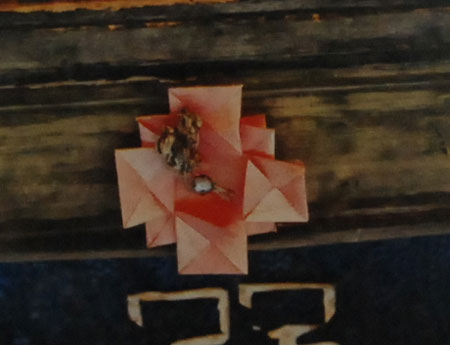
"Haystack" (Dai County, Shanxi).
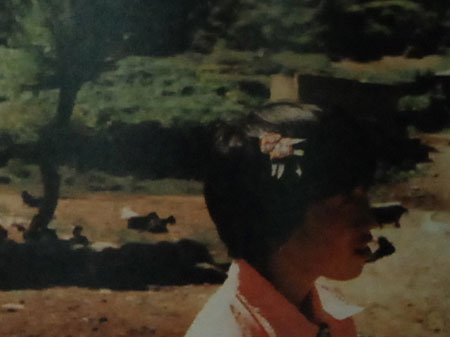
"Silver ingot" (Dai County, Shanxi).
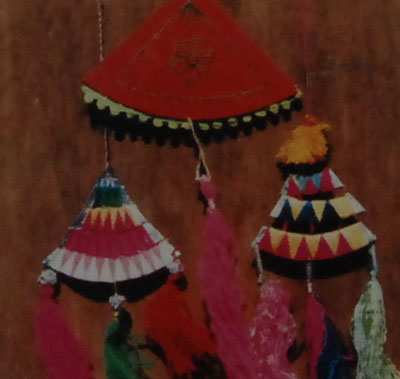
Pyramid-shaped dumpling ornament (Zhengning.Gansu)
Another custom is to eat pyramid-shaped steamed dumplings made with glutinous rice, red been and jujubes wrapped in reed leaves. Imitation of its hexagon shape is one of the most popular ornaments to wear on the occasion. With blue, red, white, yellow and black threads winding around it, it is quite eyes-catching. The colors of the threads stand for spring (blue), summer (red), long summer (white), fall (yellow), and winter (black). These are the colors of grass and trees from sprouting to withering a year round. In the eyes of the Chinese community, red, yellow, blue, white and black five colors are the colors that compose the universe.
In folk paper-cut and embroidery words animals holding grass in the mouth are legendary animals, not natural animals, such as a "Fish holding grass in the mouth," or a rooster, a deer, a rabbit, a sheep, a tiger, a snake, etc. The animals with acrimony appeared in some local art works are connected with the primitive totem symbols idolized in that area. Mugwort was later sanctified by Taoism as "glossy ganoderma." Then the grass accompanying the totem animals also changed to "A deer holding glossy ganoderma in the mouth/' or a tiger, a snake "holding glossy ganoderma in the mouth." These animals were considered symbol of good fortune and celestial being. However, the original art form of "A snake holding mugwort in the mouth" was from the 5000-year-old painted pottery unearthed from Xiangfen of Shanxi Province. The grass in that painting should be mugwort. The same is true in the paper-cut "A snake twining round a rabbit" and "A snake holding grass in the mouth," which are still quite popular in this area today.
Dragon has been a totem figure for all nationalities in China. The 5th of the fifth lunar month is dying Dragon Rising Day. Every year on this day, the bustling dragon boat race along the Yangtze River valley; and nationwide festivities like the dragon lantern fair, dragon dance, lion (belong to tiger branch) dance, are of great cultural and art values.





